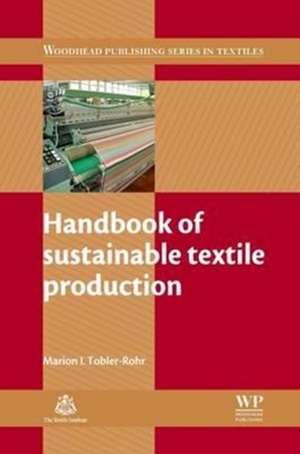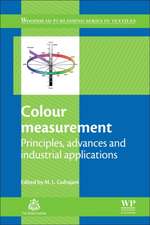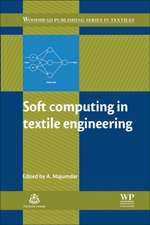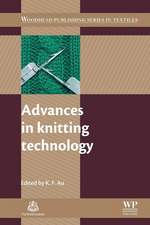Handbook of Sustainable Textile Production: Woodhead Publishing Series in Textiles
Autor Marion I Tobler-Rohren Limba Engleză Paperback – 18 aug 2016
- A detailed, quantitative assessment of the sustainable development of textiles
- Provides a useful compilation of technical, economical, and environmental data from various processes in the textile manufacturing chain
- Chapters define the principles of sustainability and its use in legislation and industry, textile process technology, the impact of textiles throughout the supply chain, raw fibre through to fabric production, consumption and disposal
Din seria Woodhead Publishing Series in Textiles
- 9%
 Preț: 947.93 lei
Preț: 947.93 lei - 9%
 Preț: 802.07 lei
Preț: 802.07 lei - 24%
 Preț: 802.53 lei
Preț: 802.53 lei - 9%
 Preț: 1158.65 lei
Preț: 1158.65 lei - 19%
 Preț: 340.02 lei
Preț: 340.02 lei - 24%
 Preț: 1133.92 lei
Preț: 1133.92 lei - 24%
 Preț: 1276.30 lei
Preț: 1276.30 lei - 24%
 Preț: 1132.28 lei
Preț: 1132.28 lei - 24%
 Preț: 949.23 lei
Preț: 949.23 lei - 24%
 Preț: 1162.55 lei
Preț: 1162.55 lei - 9%
 Preț: 1007.18 lei
Preț: 1007.18 lei - 24%
 Preț: 863.89 lei
Preț: 863.89 lei - 24%
 Preț: 1131.24 lei
Preț: 1131.24 lei - 9%
 Preț: 947.06 lei
Preț: 947.06 lei - 9%
 Preț: 1021.10 lei
Preț: 1021.10 lei - 9%
 Preț: 951.37 lei
Preț: 951.37 lei - 24%
 Preț: 1067.05 lei
Preț: 1067.05 lei - 24%
 Preț: 1511.33 lei
Preț: 1511.33 lei - 24%
 Preț: 1131.59 lei
Preț: 1131.59 lei - 9%
 Preț: 865.84 lei
Preț: 865.84 lei - 24%
 Preț: 1195.56 lei
Preț: 1195.56 lei - 23%
 Preț: 911.09 lei
Preț: 911.09 lei - 24%
 Preț: 1027.26 lei
Preț: 1027.26 lei - 29%
 Preț: 845.48 lei
Preț: 845.48 lei - 24%
 Preț: 1232.53 lei
Preț: 1232.53 lei - 9%
 Preț: 1007.18 lei
Preț: 1007.18 lei - 20%
 Preț: 1125.16 lei
Preț: 1125.16 lei - 20%
 Preț: 1185.64 lei
Preț: 1185.64 lei - 9%
 Preț: 1272.93 lei
Preț: 1272.93 lei - 31%
 Preț: 1090.57 lei
Preț: 1090.57 lei - 9%
 Preț: 1156.05 lei
Preț: 1156.05 lei - 24%
 Preț: 1159.97 lei
Preț: 1159.97 lei - 5%
 Preț: 838.79 lei
Preț: 838.79 lei - 39%
 Preț: 803.30 lei
Preț: 803.30 lei - 9%
 Preț: 1092.20 lei
Preț: 1092.20 lei - 29%
 Preț: 1426.03 lei
Preț: 1426.03 lei - 23%
 Preț: 309.98 lei
Preț: 309.98 lei - 20%
 Preț: 883.71 lei
Preț: 883.71 lei - 24%
 Preț: 924.65 lei
Preț: 924.65 lei - 29%
 Preț: 1210.65 lei
Preț: 1210.65 lei - 5%
 Preț: 1001.89 lei
Preț: 1001.89 lei - 9%
 Preț: 726.56 lei
Preț: 726.56 lei - 31%
 Preț: 728.30 lei
Preț: 728.30 lei - 39%
 Preț: 899.39 lei
Preț: 899.39 lei - 9%
 Preț: 986.86 lei
Preț: 986.86 lei - 24%
 Preț: 988.42 lei
Preț: 988.42 lei - 9%
 Preț: 1045.16 lei
Preț: 1045.16 lei - 9%
 Preț: 1167.80 lei
Preț: 1167.80 lei
Preț: 932.01 lei
Preț vechi: 1024.19 lei
-9% Nou
Puncte Express: 1398
Preț estimativ în valută:
178.36€ • 185.53$ • 147.25£
178.36€ • 185.53$ • 147.25£
Carte tipărită la comandă
Livrare economică 07-21 aprilie
Preluare comenzi: 021 569.72.76
Specificații
ISBN-13: 9780081016947
ISBN-10: 0081016948
Pagini: 520
Dimensiuni: 156 x 234 x 27 mm
Greutate: 0.72 kg
Editura: ELSEVIER SCIENCE
Seria Woodhead Publishing Series in Textiles
ISBN-10: 0081016948
Pagini: 520
Dimensiuni: 156 x 234 x 27 mm
Greutate: 0.72 kg
Editura: ELSEVIER SCIENCE
Seria Woodhead Publishing Series in Textiles
Cuprins
Author contact details
Woodhead Publishing Series in Textiles
Foreword
Preface
Acknowledgments
Chapter 1: Sustainable development (SD) as a goal in production, marketing and trade
Abstract:
1.1 A holistic concept
1.2 Theory behind sustainable development
1.3 Sustainability in the public sector
1.4 Sustainability in industry
1.5 Environmental management systems
1.6 Environmental labeling
Chapter 2: The supply chain of textiles
Abstract:
2.1 Introduction
2.2 Natural fibers
2.3 Man-made fibers and filament and yarns
2.4 Energy
2.5 Yarn production
2.6 Fabric production
2.7 Chemical treatment
2.8 Manufacturing
2.9 Consumption, use and care
2.10 Disposal, reuse and recycling scenarios
Chapter 3: Product specification function and textile process technology
Abstract:
3.1 Introduction
3.2 Quality and textile specifications
3.3 Specification of raw material and processes
3.4 Functionality and process technology
3.5 Inherent functionality of natural fibers
3.6 Designed functionality of man-made fibers
3.7 Spinning processes: functionality in two dimensions
3.8 Functionality in three dimensions through weaving and knitting processes
3.9 Chemical treatment for customer functionality
3.10 Functionality in product development
3.11 The origin of best available technology (BAT)
3.12 Best practice in cotton growing and ginning
3.13 Optimizing energy supply in textile processing
3.14 Best mill practice
3.15 Best available technology (BAT) in finishing
3.16 Recommendations for consumption and care
Chapter 4: Life cycle assessment (LCA) and ecological key figures (EKF)
Abstract:
4.1 Introduction
4.2 Life cycle assessment (LCA) methodology
4.3 Eight case studies: scale and scope
4.4 Life cycle inventory (LCI)
4.5 Life cycle assessment (LCA) results
4.6 Life cycle assessment (LCA) sensitivity analysis
4.7 Costs
4.8 Introduction to ecological key figures (EKF)
4.9 Theory for ecological key figures (EKF)
4.10 Applied ecological key figures (EKF) in spinning and weaving
4.11 Discussion on ecological key figures (EKF) of textile products
Chapter 5: Product development and marketing: management and communication
Abstract:
5.1 Introduction
5.2 The structure of the textile and apparel sector
5.3 The marketing environment of textiles and apparel
5.4 Global trade
5.5 Consumer preferences
5.6 Positioning of companies in the market
5.7 Market segments and brands
5.8 Product development and merchandising
5.9 Distribution and distribution channels
5.10 Sourcing
Index
Woodhead Publishing Series in Textiles
Foreword
Preface
Acknowledgments
Chapter 1: Sustainable development (SD) as a goal in production, marketing and trade
Abstract:
1.1 A holistic concept
1.2 Theory behind sustainable development
1.3 Sustainability in the public sector
1.4 Sustainability in industry
1.5 Environmental management systems
1.6 Environmental labeling
Chapter 2: The supply chain of textiles
Abstract:
2.1 Introduction
2.2 Natural fibers
2.3 Man-made fibers and filament and yarns
2.4 Energy
2.5 Yarn production
2.6 Fabric production
2.7 Chemical treatment
2.8 Manufacturing
2.9 Consumption, use and care
2.10 Disposal, reuse and recycling scenarios
Chapter 3: Product specification function and textile process technology
Abstract:
3.1 Introduction
3.2 Quality and textile specifications
3.3 Specification of raw material and processes
3.4 Functionality and process technology
3.5 Inherent functionality of natural fibers
3.6 Designed functionality of man-made fibers
3.7 Spinning processes: functionality in two dimensions
3.8 Functionality in three dimensions through weaving and knitting processes
3.9 Chemical treatment for customer functionality
3.10 Functionality in product development
3.11 The origin of best available technology (BAT)
3.12 Best practice in cotton growing and ginning
3.13 Optimizing energy supply in textile processing
3.14 Best mill practice
3.15 Best available technology (BAT) in finishing
3.16 Recommendations for consumption and care
Chapter 4: Life cycle assessment (LCA) and ecological key figures (EKF)
Abstract:
4.1 Introduction
4.2 Life cycle assessment (LCA) methodology
4.3 Eight case studies: scale and scope
4.4 Life cycle inventory (LCI)
4.5 Life cycle assessment (LCA) results
4.6 Life cycle assessment (LCA) sensitivity analysis
4.7 Costs
4.8 Introduction to ecological key figures (EKF)
4.9 Theory for ecological key figures (EKF)
4.10 Applied ecological key figures (EKF) in spinning and weaving
4.11 Discussion on ecological key figures (EKF) of textile products
Chapter 5: Product development and marketing: management and communication
Abstract:
5.1 Introduction
5.2 The structure of the textile and apparel sector
5.3 The marketing environment of textiles and apparel
5.4 Global trade
5.5 Consumer preferences
5.6 Positioning of companies in the market
5.7 Market segments and brands
5.8 Product development and merchandising
5.9 Distribution and distribution channels
5.10 Sourcing
Index
Recenzii
"This book is without a doubt the most thorough book on the full range of issues encountered in the sustainability discussion in textiles and fashion. It is very much worth its price and space on the bookshelf." --Shirahime















